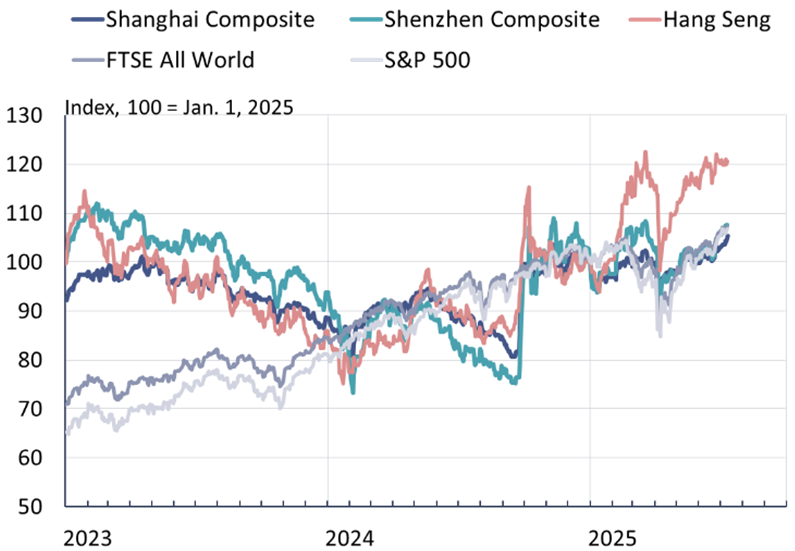BOFIT Weekly Review 28/2025
Hong Kong stock market surges as IPOs soar in the first half of the year; mainland China exchanges relatively subdued
On Thursday (July 10), the Hong Kong Stock Exchange’s main Hang Seng index was up by 21 % from the start of the year. The main share indices for the Shanghai and Shenzhen stock exchanges were up by 5 % and 8 %, respectively. The largest index for mainland Chinese firms, the CSI300, was up 2 % from the start of the year. Share prices fell considerably in early April following US president Donald Trump’s declaration of hefty reciprocal tariffs. Stock markets, including those in China, rebounded quickly on news of a delay in the new tariff regime.
IPOs on the Hong Kong Stock Exchange in the first half of the year raised $14 billion, more than seven times the amount raised during the same period last year, and largest among global exchanges. Most IPOs were for large Chinese companies already listed on mainland exchanges, including battery-maker CATL, the largest listing globally this year. Many more Chinese firms are still planning IPOs in Hong Kong this year. The increase in IPOs reflects robust market liquidity and regulatory reforms that have sped up the listing process. It is much easier for foreign investors to trade directly in shares of Chinese firms on the Hong Kong exchange than access mainland China exchanges through “Stock Connect” trading platforms.
China’s largest companies have traditionally favoured US stock markets for raising foreign capital, but recent geopolitical tensions have dampened interest in new listings and many big companies have delisted from US exchanges. Nevertheless, Nasdaq hosted 34 listings of Chinese firms in the first half of this year, although most of the companies were tiny. The US Securities and Exchange Commission (SEC) is tightening rules for foreign firms, which could complicate life for Chinese IPOs in the future. Moreover, the recently gained access by US officials to inspect the audits of Chinese companies, along with the heightened risk of possible delisting on political or national security grounds, is making US listings less attractive.
In recent years, IPO approvals on mainland China exchanges have been restricted, and the listing process has been considerably slower than for exchanges elsewhere. The approval process seems to have sped up this year, however. During January-June, a total of 51 IPOs were held (44 in 1H24). Furthermore, stock exchanges accepted many more IPO applications for review (177) than last year, of which, the Beijing Stock Exchange received the largest number (97). The Beijing Stock Exchange, founded in 2021, is significantly smaller than the other two mainland stock exchanges and focuses on raising capital for smaller firms. At the end of 2024, 262 firms were listed on the Beijing bourse, compared to over 1,700 firms on the Shanghai Stock Exchange, just under 2,900 on the Shenzhen exchange and over 2,600 on the Hong Kong exchange.
The Chinese government this year has promoted more efficient capital markets in order to support companies and especially technology innovation. In June, mainland companies listed in Hong Kong were given the opportunity to list on the Shenzhen exchange. Previously, only the reverse form of dual listing was possible, requiring the newcomer firm to first list on a mainland China exchange. In July, the Shenzhen Stock Exchange also announced plans to expedite the listing process and urged stockbrokers to speed up new IPOs, particularly fast-tracking tech firms seeking inclusion in the ChiNext list of high-growth firms in the technology sector.
Foreign entities still have only a minor presence on mainland China stock exchanges. As of end-March, foreign investors held Chinese stocks worth just under 3 trillion yuan ($410 billion), which was only 3.4 % of total stock market capitalisation. While the value of foreign holdings has risen a bit from a year ago, it is still nearly 1 trillion yuan below its 2021 peak.
Hong Kong’s Hang Seng Index has outperformed both mainland Chinese and global markets in share price growth this year

Sources: Macrobond and BOFIT